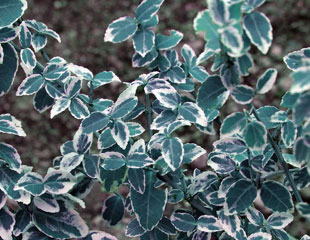

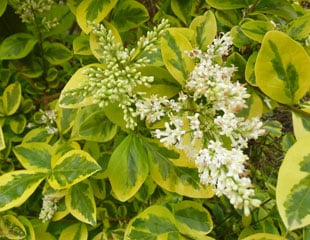
How to Grow Euonymus
Euonymus is a commonly grown garden staple. There are both evergreen and deciduous varieties.
The fortunei cultivars, which are many evergreen varieties, are grown for their brightly coloured foliage. Illustrated above left is E. fortunei 'Harlequin' which is a low growing compact variety with a slight pink tinge to the leaves. On the right is the frequently grown E. fortunei 'Emerald n Gold', a really bright shrub which will light up a shady corner, being tolerant of partial shade. The advantage of growing Euonymus is that they are tough shrubs which will tolerate less than ideal conditions, making them suitable for growing in a difficult area of the garden.
Euonymus grow best in a reasonably well-drained soil, in sun or partial shade. Euonymus will not tolerate deep shade. You can plant Euonymus at any time of the year, as long as the ground is not frozen. These plants are hardy to H5. The variegated varieties do better with more sun. Euonymus are easy to grow and virtually maintenance free. Euonymus are ideal for hedging, varieties such as Emerald n Gold, and E. Emerald Gaiety which are also reasonably quick growing.
Below are images of two of the most commonly grown evergreen varieties, Euonymus fortunei 'Emerald ‘n‘ Gold (right) and Silver Queen (centre) illustrated as mature shrubs. Included in the centre image is Euonymus alatus, one of the best shrubs for autumn colour. More growing information about E. alatus, and shrubs good for autumn colour.
The fortunei varieties are tough and will grow in an exposed site, windy areas, partial shade, which makes them a useful garden shrub, particularly for difficult areas. They will also tolerate alkaline soil.
As with all variegated plants, reversion can occur. This is when the new growth is without variegation. Should this occur, prune out the reversionary growth back to the main shrub to maintain the variegated foliage.
Euonymus is versatile, with excellent variegated foliage and often overlooked as a commonplace shrub, but to do so would under estimate their garden value as a maintenance free garden shrub with lovely variegated foliage.
Check out Fast Growing Evergreen Shrubs for more planting ideas.
How and when to prune Euonymus
Euonymus do not require routine pruning. Sometimes the evergreen variety may require pruning if they are displaying weak spindly stems, uneven growth or shape, or have become overgrown requiring renovation.
Prune in early spring before the new growth is evident. Cut out any poor stems, and lightly trim into shape. Take out any dead or damaged stems. If there is uneven growth level up. This is also the time to prune Euonymus if you are growing as a hedge to trim into shape.
If the Euonymus has become overgrown, you can renovate it by hard pruning. It is best undertaken gradually, removing around 1/3 of the overgrown material each spring.
Euonymus lightening up the gloom

Lots of gardens have darker areas and this is a shady area in winter, which tends to be gloomy.
But see how the bright, variegated Euonymus lightens up the area and stands out.
Apart from the wide range of Euonymus which grow in partial shade brighten up a darker area, Fatsia japonica the Spider's Web Fatsia which is variegated would also suit such a position, as would Ilex, the common holly which will also tolerate dense shade.
Winter shrub combination Euonymus and Sarcococca

This is an attractive winter shrub combination. Euonymus fortunei 'Emerald N Gold' and Sarcococca common name Sweet Box.
Both shrubs will grow in semishade, an ideal combination for a partially shade corner of the garden. To make this work, pick a variety of Sarcococca, which is one of the taller growing varieties so it matches up with the Euonymus.
This combination is evergreen, with bright colour from the Euonymus and best of all, lovely sweet scented flowers on the Sarcococca, hence its common name of Sweet Box. Both are easy to grow, fully hardy and need no maintenance.
Pests: Euonymus Scale
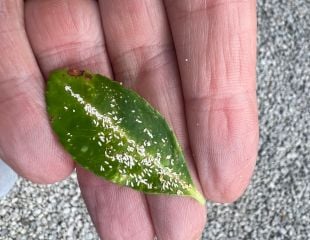
Have you got this infesting your Euonymus? If so it is Euonymus Scale follow this link for more information and how to eradicate it.

Euonymus is easy to grow, tough tolerant of all growing conditions, maintenance free definitely and a green wheelbarrow shrub.
Euonymus planting combination
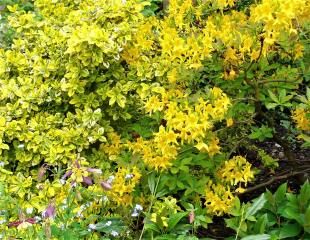
Euonymus planting scheme in the image which is Euonymus fortunei 'Emerald and Gold', a yellow flowering Rhododendron luteum, (which is wonderfully scented) and Aquilegia 'Swan Lavender' a brilliant bright spring combination.
Euonymus flowering

Euonymus fortunei 'Emerald and Gold' has attractive white flowers, which add to its value as a great garden shrub.
Silver leaved Euonymus
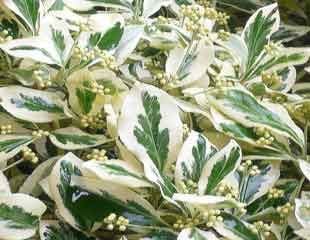
There are also some very good silver leaved varieties of Euonymus.
Euonymus alatus 'Compactus'
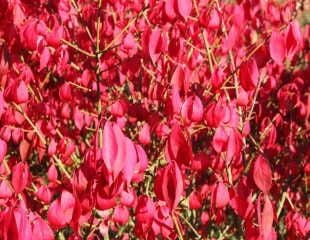
As the name suggests, a deciduous compact form of Euonymus growing to around 1.5 with fantastic autumn colour. This variety and other Euonymus are available from Crocus.
